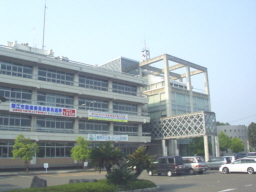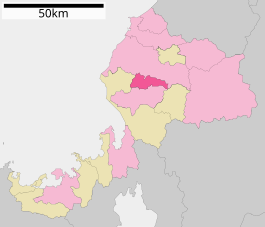Sabae, Fukui
Sabae (鯖江市, Sabae-shi) is a city located in Fukui Prefecture, Japan.
Sabae
鯖江市 | |
|---|---|
 Sabae City Hall | |
 Sabae in Fukui Prefecture | |
| Country | |
| Region | Chūbu |
| Prefecture | |
| Government | |
| • Mayor | Katsuhisa Sasaki |
| Area | |
| • Total | 84.59 km2 (32.66 sq mi) |
| Population (October 1, 2020) | |
| • Total | 68,302 |
| • Density | 807.4/km2 (2,091/sq mi) |
| Time zone | UTC+09:00 (JST) |
| Postal code | 916-8666 |
| Area code | 18207-9 |
| Phone number | 0778-51-2200 |
| Address | 13-1 Nishiyamachō, Sabae-shi, Fukui-ken |
| Website | Official website |
History
changeIn 1889, the municipal system was introduced. 1 city - Fukui, 9 towns and 168 villages were established.
Sabae was one of 9 towns. It had administrated 10 villages. These villages are: Funatsu Village, Shin-Yokoe Village, Shinmei Village, Tachimachi Village, Yoshikawa Village, Yutaka Village, Nakagawa Village, Katakami Village, Kitanakayama Village, Kawada Village.
In 1948 Funatsu Village and Shin-Yokoe Village became a part of Sabae Town. Since then Sabae Town was gradually growing until it became Sabae City.
Gozaemon Masunaga, the "ancestor of domestic eyeglasses," started manufacturing eyewear frames in Fukui around 1905. At that time, most people in Sabae were working in the farming industry. Farming was challenging in winter, since the Fukui region experiences a lot of snow. Masunaga started this industry because the eyeglass industry does not depend on the season. He invited craftsmen from Osaka to try to spread the industry as a side business of a farmer in Fukui. At that time, education and the development of printing technology were spreading so people started to read prints such as newspapers. The demand for eyewear has expanded. In 1935, the eyewear industry spread to Sabae and Fukui. The industry succeeded in manufacturing the titanium-based eyewear frames in 1981 for the first time in the world. After that, a large military factory was converted to an eyewear factory after the end of World War II made Sabae’s eyeglasses industry famous.
Edo period
changeFrom the beginning Sabae was ruled by Manabe Clan. The Sabae area used to be the gate town of Jōshō Temple. In the Edo period, the West-Sabae Jin'ya (administrative headquarter for a small province) was under the direct control of the Shogunate. At that time, Sabae was the gate town until 1871. In meantime Sabae Jin'ya became Sabae Han (historical term for the estate of a daimyo in the Edo period) (1720-1871)
Manabe Akikatsu (1804-1884) is known as the most famous Sabae's feudal lord, who in 1856 opened Kyōyōkei - a place where the lords can relax. Kyōyōkei was the foundation of the current Nishiyama Park.
When Sabae became Han there was a plan to build a castle. However, the Sabae Castle was never built. There were many problems such as financial difficulties and the occurrence of famine. Instead, Manabe Akikatsu took the money that was meant for the castle and gave it to the villages that were suffering from famine.
Geography
changeSurrounding municipalities
changeDemography
changeAccording to Japanese census data,[1]
| 1995 | 2000 | 2005 | 2010 | 2015 | 2020 |
|---|---|---|---|---|---|
| 62,890 | 64,898 | 66,831 | 67,450 | 68,284 | 68,302 |
Culture
changeFormer Uryu Residence
changeIt is the oldest residence in Fukui Prefecture. Originally located on the east side of the former Hokuriku Expressway, but it was relocated to northeastern corner of the Shinmeisha (Shintō Shrine) in 1975.
Jōshō Temple
changeBuddthist temple which building stared in 1208. Shisoku Gate of this temple is a cultural property.
Nishiyama Park
changeNishiyama Park is considered to be one of 100 historical parks in Japan. There is also a zoo, which is famous for having Red Pandas, an adventure forest and Japanese garden.
Economy
changeSabae is one of the largest manufacturer of eyeglass frames in Japan.[2]
Eyeglasses
changeSabae eyewear is produced in Sabae City, one of the world's three largest eyewear production areas. Fukui Prefecture, particularly Fukui City and Sabae City, manufactures high quality frames that account for 95% of all Japanese eyewear frames sold both nationally and internationally. About 4000 people are involved in the local industry, and it takes about half a year to a year to manufacture one pair of eyewear. Sabae eyewear is manufactured with the technology of titanium.
The technology is also used in producing medical and electronic equipment. There are more than 5,000 stores in Japan that sell Sabae eyeglasses, and the average price is 35,000 yen excluding lenses now.
Process
changeMore than 200 steps are required to complete one eyeglasses frame. However these processes can be divided into 9 processes.
- Design: In this process, eyewear is designed by craftsmen using a computer and paper. They focus on how people who wear the eyewear feel. This is the most important part of the production process.
- Mold-Making: In this process, a metal is cut very precisely to make the shape of eyewear.
- Press: In this process, the parts which are used to make metal frames are pressed many times by machine
- Precision Cutting: In this process, parts are precisely cut in a short time by craftsmen.
- Brazing: In this process, parts are bonded, or brazed, at temperatures of 700 degrees or higher.
- Polishing: In this process, it is polished by craftsmen to erase damages and make gloss.
- Inspection: In this process, the products are inspected by craftsmen to find defective products again and again for safety.
- Surface Treatment: In this process, it is plated gold to prevent corrosion and make its appearance beautiful.
- Finishing: In this process, the entire pair of glasses is balanced as a finish work.
References
change- ↑ Sabae population statistics
- ↑ Lewis, Leo (April 4, 2018). "Made in Japan: can handcrafted glasses survive an automated world?". Financial Times. Archived from the original on April 24, 2018. Retrieved June 3, 2018.

